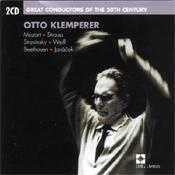|
You are reading the older HTML site Positive Feedback ISSUE 12march/april 2004
Great Conductors of the 20th Century: Otto Klemperer
RIAS Symphony, *Cologne
Radio Symphony, **Berlin State Opera Orchestra, +Bavarian Radio Symphony,
++Berlin Radio Symphony/Otto Klemperer MOZART: Symphonies: No. 38 in D, K.504 ("Prague"); No. 25 in G minor, K. 183. R.STRAUSS: Till Eulenspiegel, Op. 28*. STRAVINSKY: Pulcinella: Suite+. WEILL: Kleine Dreigroschenmusik: excerpts**. BEETHOVEN: Symphony No. 2 in D, Op.36++. JANÁČEK: Sinfonietta*. The curiosity here is the 1956 broadcast of the Sinfonietta by Janáček. Klemperer didn't record his music commercially - no one much did, back then, beyond the Czech lands - but he obviously finds the style congenial. Where Rattle and other international exponents bathe the music in glamorous, Hollywoodian sonorities, Klemperer follows native Czech practitioners in keeping the strings lean and focused, playing up the prominent brass writing, underlining the composer's angular austerity. The introductory Fanfares, broader than we usually hear, sound a truly grand invocation; the faster passages of the fourth and fifth movements gain from a hint of extra breathing time, without losing propulsion. Unfortunately, for all EMI's industry in tracking down and licensing airchecks and "lost" recordings, the rest of the set is of minimal documentary value, as Klemperer would eventually re-record most of these pieces under controlled conditions. This Beethoven Second Symphony, recorded in concert, boasts translucent string tone and an easy, singing flow in the Adagio introduction and the Larghetto movement, while a rugged weight underpins the mercurial outbursts of the last two movements. But Klemperer does all the same things equally well in his Philharmonia remake, in incomparably better sound. Similarly, I enjoyed Till Eulenspiegel's cheeky high clarinet solos and the coda's unexpected veering into nostalgic warmth, but it doesn't immediately jump to the top of a very long list. The two Mozart symphonies, with the RIAS Orchestra, are impulsive, even skittish. The exposition repeats rush - perhaps the players were uncomfortable with Klemperer, or vice versa - and the Andantes push forward nervously; the ease displayed by the Berlin Radio forces in the Beethoven is lacking here. These readings are simply too unsettled, despite the operatic drama with which the conductor invests Symphony 25. The Stravinsky is on a par with Klemperer's Philharmonia recording: some passages sing attractively - the Bavarian oboist has a fuller tone than his London counterpart - while others sound thick and insufficiently sorted out. It's interesting to hear the Weill excerpts recorded in 1931, when they were "contemporary" - but who wants just nine-plus minutes of the suite? At no point, by the way, is the monaural sound state-of-the-art for its time (the 1950s, save in the Weill, with climaxes subject to breakup and overload. Stephen Francis Vasta
|

